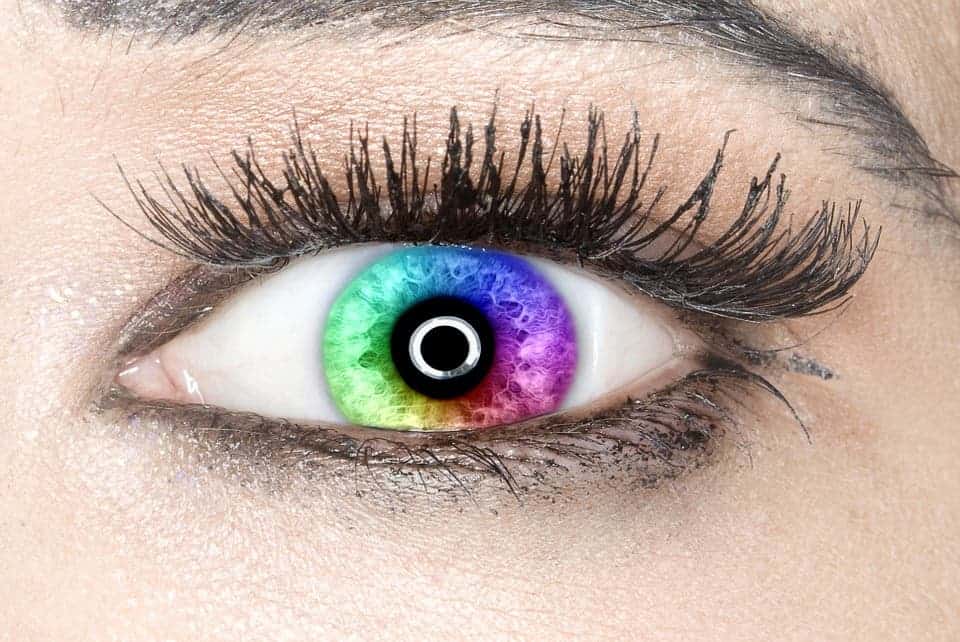Neuroscientists in the UK have recently announced that their 25 year long search for a tetracromath — a person with an extra type of cone cell in his or her retina — has finally come to a successful end. They estimate that the woman can see a staggering 99 million more colors than other humans, and they believe there are many more people like her waiting to be discovered.

Our eyes‘ retina house cone cells that can distinguish color variation in incoming light. Humans usually have three types of cone cells, each able to detect the presence of a single color — green, red, or blue — and are thus known as “trichromats.” Most color blind people and most other mammals only have two different types of cone cells, and are “bichromats.” As each cell can distinguish between 100 or so shades of the same color, each extra type of cone cell increases the number of colors we can see exponentially. So where a color blind person can see around 10,000 shades, a healthy human can see around 1 million different colors.
But what if human beings had not three, but four types of cone cells in their retinas? That would allow a person to see 100 million colors — colors most of us have never even dreamed of, colors we have no way of even imagining. The existence of such people, or “tetrachromats,” was first proposed in 1948 by Henri Lucien de Vries, a Dutch scientist researching with color blind patients. He found that while his male subjects had two types of normal cone cells and one mutant type that was less sensitive and didn’t pick up on its corresponding color (either green or red,) the female subjects had three normal cone cell types and one mutant type. Even if this extra type of cell didn’t actually do anything, it suggested that humans can have more than three types of cells.
Interest in tetrachromats largely died out until the late ’80s, when Professor John Mollon from Cambridge University started looking for women who might have four functioning cone cell types. He estimated that, if color blind men could pass this fourth cell type to their daughters, around 12% of the female population should be tetrachomats. However, he never actually found a person with four different fully functional types of cone cells, a tetrachromat.
But now, 25 years after they’ve first started searching, UK scientists believe they’ve finally found such a woman. Known as cDa29, she was identified by Newscastle University neuroscientist Gabriele Jordan, a former coleague of Mollon, after she decided to use a different test than those the professor employed in his search.
She took 25 women who had a fourth type of cone cell, and put them in a dark room. Looking into a light device, three colored circles of light flashed before these women’s eyes. To you and me the circles would look the same, but Jordan believed that a true tetrachromat could tell them apart, as the fourth type of cone cells would allow her to pick up on the subtle differences.
One of the women tested, cDa29, was able to differentiate the three different colored circles on every single try.
“I was jumping up and down,” Jordan told Discover magazine.
But why did it take so long to find a tetracromat if there’s so many of them? One issue is that the team only carried out their search in the UK. But more importantly, Jordan says, is that most true tetrachromats simply don’t know they’re any different from the rest of us.
“We now know tetrachromacy exists,” she said. “But we don’t know what allows someone to become functionally tetrachromatic, when most four-coned women aren’t.”
Jay Neitz, a vision researcher at the University of Washington, who wasn’t involved in the study, thinks that tetrachromats simply haven’t had a chance to use their eyes to their full potential in our society.
“Most of the things that we see as coloured are manufactured by people who are trying to make colours that work for trichromats,” he said. “It could be that our whole world is tuned to the world of the trichromat.”
The research on cDa29 hasn’t been peer-reviewed or published as yet, and Jordan is continuing her research and search for more tetrachromats. Her results still need to be verified but if tetrachromats really do exist, it could teach us a lot about how vision works.
One thing we might never be able to understand, however, is exactly what the world looks like through cDa29’s eyes.
“This private perception is what everybody is curious about,” Jordan told Discover. “I would love to see that.”
Was this helpful?



